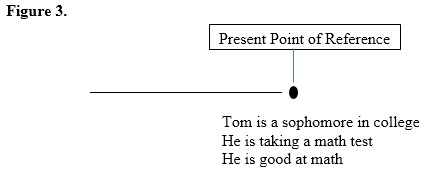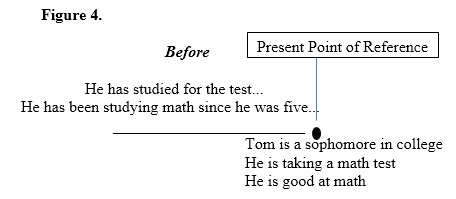









Douglas Adams

|









|
Editor: Douglas Adams |
|
|
|
The Present Tenses [Table Format]
Notice that the only part of the basic formula for the continuous and perfect forms that changed from the basic pattern is the "be" and "have" Like the past tenses, learning the formulas for the present tense verbs is just the first step. Using these tenses within a context is often more challenging, so let's look at an example. Tom is a sophomore in college, and he is taking a test in math. He has studied for the test, so he should get an "A". He has been studying math since he was five, and is pretty good at it.
In this short example, we can see each of the four present tenses in context, and can ask students to place them on a time line. Just as with the past, the simple present and present continuous tenses can be used to talk about some actions that happen or are happening at some point in the present. In other words, these tenses place us at some particular point of reference in the present, and depict events that are happening at that point in time.

A quick look at our sample paragraph also reveals that the present perfect and present perfect continuous tenses are used to talk about things that happened or were happening before the simple present and present continuous actions. In fact, just as in the past, we can think of the present perfect tenses as the before tenses since they are always used for actions that happen before some present point of reference whether that point is directly stated or merely implied.
 ** the present continuous form of the verb implies that Tom continues to do this even at the point he a sophomore and taking the test. Again, this pattern of the simple and continuous tenses establishing a point of reference in time and the perfect and perfect continuous tenses describing actions happening before that point is repeated for all the tenses (past, present, and future). However, before delving into the future tenses, it's worthwhile at this point to take a closer look at how the present and past tenses relate to one another and show students another area of choice in the tense system. How do the present and past tenses overlap?
Special Note:
Issues with the simple present vs. present continuous
At this point let's turn our attention to
The Future Tenses
|
|||||||||||||||||||||||||||||||||||||||||||||||||||||||||||||||||||||||||||||||||||||||||||||||||||||||||||||||||||||||||
|
|
|||||||||||||||||||||||||||||||||||||||||||||||||||||||||||||||||||||||||||||||||||||||||||||||||||||||||||||||||||||||||||
|
|
http://www.tesltimes.org |